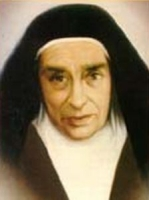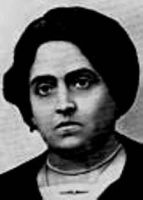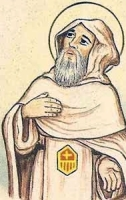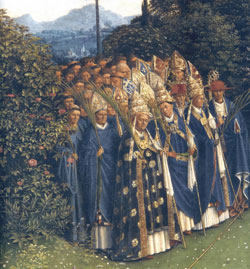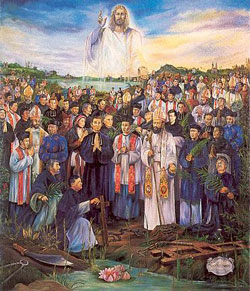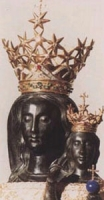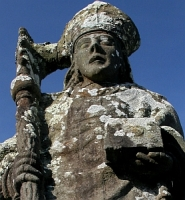Bl. Peter Tecelano
Peter Tecelano
Feastday: December 10
Death: 1287
Franciscan mystic. A native of Campi, Tuscany, Italy, he was trained as a comb maker at Siena. After the death of his wife he entered the Franciscans as a tertiary and served as nurse to the sick in a Franciscan hospital. He also toiled making combs. In his lifetime, he was reputed to be a deeply mystical and holy individual and was credited with miracles. He was beatified in 1802, in part because of miracles reported as occurring at his tomb.
St. Peter Duong
Peter Duong
Feastday: December 10
Death: 1838
Canonized: Pope John Paul II
Vietnamese martyr. A native of Vietnam, Peter served as a catechist and, with Peter Truat, was martyred by anti-Christian forces.
The Vietnamese Martyrs (Vietnamese: Các Thánh Tử đạo Việt Nam; French: Martyrs du Viêt Nam), also known as the Martyrs of Annam, Martyrs of Tonkin and Cochinchina, Martyrs of Indochina, or Andrew Dung-Lac and Companions (Anrê Dũng-Lạc và các bạn tử đạo), are saints on the General Roman Calendar who were canonized by Pope John Paul II. On June 19, 1988, thousands of overseas Vietnamese worldwide gathered at the Vatican for the Celebration of the Canonization of 117 Vietnamese Martyrs, an event chaired by Monsignor Tran Van Hoai. Their memorial is on November 24 (although several of these saints have another memorial, having been beatified and on the calendar prior to the canonization of the group).
Saint John Roberts
தூய ஜான் ராபர்ட்ஸ்
இன்று நாம் நினைவுகூரும் ஜான் ராபர்ட்ஸ், இங்கிலாந்தில் உள்ள நார்த் வேல்ஸில், 1577 ஆம் ஆண்டு பிறந்தார். இவருடைய குடும்பம் ஒரு செல்வச் செழிப்பான குடும்பம். அதனால் இவர் எல்லா வசதிகளும் கிடைக்கப்பெற்று மிகவும் மகிழ்ச்சியாக வாழ்ந்து வந்தார்.
இவருடைய பெற்றோர் ப்ராடெஸ்டென்ட் சபையைச் சார்ந்தவர்கள். அதனால் இவரும் சிறுவயது முதலே பிராடெஸ்டென்ட் நம்பிக்கையிலே வளர்ந்துவந்தார். ஒருசமயம் கத்தோலிக்கத் திரு அவையைச் சார்ந்த குருவானவர் ஒருவர், கத்தோலிக்கத் திரு அவையின் போதனைகளையும் மறையுண்மைகளையும் எடுத்துரைத்ததைக் கேட்டுவிட்டு, ஜான் ராபர்ட்ஸ் கத்தோலிக்கத் திரு அவைமீது ஈடுபாடு கொள்ளத் தொடங்கினார். 1598 ஆம் ஆண்டு இவர் பாரிஸ் நகருக்கு படிக்கச் சென்றபோது, அங்கு கிடைத்த ஒருசில கத்தோலிக்க நண்பர்களின் எடுத்துக்காட்டான வாழ்வால் ஜான் ராபர்ட்ஸ் கத்தோலிக்கத் திரு அவைக்கு வந்தார்.
நாட்கள் செல்லச் செல்ல கத்தோலிக்கத் திரு அவையின் போதனைகள் ஜான் ராபர்ட்ஸிடம் பெரிய ஒரு மாற்றத்தைக் கொண்டுவந்தது. அதனால் இவர் ஸ்பெயின் நாட்டிற்குச் சென்று, குருத்துவ வாழ்விற்கு தன்னையே தயார் செய்து, 1602 ஆம் ஆண்டு குருவாக மாறினார். இதற்குப் பின்பு இவர் அருட்தந்தை அகஸ்டின் ப்ராட்சா என்பவரோடு சேர்ந்து இங்கிலாந்து நாட்டிற்கு நற்செய்தி அறிவிக்கச் சென்றார். இங்கிலாந்து நாட்டில் கத்தோலிக்க நம்பிக்கையை அறிவிப்பது என்பது அவ்வளவு எளிதான காரியமாக இருந்துவிடவில்லை. அதற்கு இங்கிலாந்து நாட்டை ஆண்டுவந்த முதல் எலிசபெத் அரசியிடமிருந்து பயங்கர எதிர்ப்பு இருந்தது.
இதனைக் கண்டு பயன்படாமல் ஜான் ராபர்ட்சும் அவரோடு சென்ற அருட்தந்தையும் மாறுவேடம் போட்டுக்கொண்டு ஆண்டவருடைய நற்செய்தியை எடுத்துரைத்து, பலரையும் கத்தோலிக்க நம்பிக்கைக்குள் கொண்டுவந்தார்கள். இது எப்படியோ அரசிக்குச் தெரியவர, அவர், இவர்கள் இருவரையும் நாட்டைவிட்டே துரத்திவிட்டார். இதனால் இருவரும் பிரான்சில் உள்ள டுவே என்ற நகருக்கு வந்து, சில மாதங்கள் அங்கு தங்கி பணிசெய்தார்கள். ஆனால், அதே ஆண்டில் (1603) லண்டனில் கொள்ளைநோய் பரவிய செய்தியைக் கேட்டு, அங்கு உள்ள மக்களுக்கு உதவுவதற்காக ஜான் ராபர்ட்ஸ் மட்டும் அங்கு வந்தார். நோயினால் பாதிக்கப்பட்ட மக்களுக்கு இரவுபகல் பாராது உதவினார். ஆனால் ஜான் ராபர்ட்ஸ் இங்கிலாந்தில்தான் இருக்கின்றார் என்ற செய்தியைக் கேள்விப்பட்ட எலிசபெத் அரசி, 8 மாதங்கள் அவரை சிறையில் அடைத்துவைத்து சித்ரவதை செய்து அனுப்பினார். இதற்குப் பின்பு அரசி ஜான் ராபர்ட்சை நாட்டிற்குள் வரவேகூடாது என்று எச்சரித்து அனுப்பி வைத்தார்.
எனவே ஜான் ராபர்ட்ஸ் பிரான்ஸ் நாட்டிற்குச் சென்று டுவேவில் ஒரு துறவுமடத்தை நிறுவினார். அவர் நிறுவிய அந்த துறவுமடத்தில் ஏராளமான இளைஞர்கள் வந்து சேர்ந்து, துறவிகள் ஆனார்கள். இதற்கிடையில் 1606 ஆம் ஆண்டு, ஜான் ராபர்ட்சிற்கு மீண்டுமாக இங்கிலாந்து நாட்டிற்குச் சென்று நற்செய்தி அற்விக்கவேண்டும் என்ற எண்ணம் ஏற்பட்டது. அதனால் இவர் அங்கு சென்று நற்செய்தி அறிவிக்கத் தொடங்கினார். ஆனால் எலிசபெத் அரசியுடைய ஒற்றர்களின் கையில் மாட்டிக்கொண்டதால், சிறையில் அடைக்கப்பட்டு சித்ரவதை செய்யப்பட்டார். ஓரிரு மாதங்கள் சிறையிலே இருந்த ஜான் ராபர்ட்ஸ், ஒருநாள் தப்பித்து வெளியே வந்துவிட்டார்.

இப்படி ஜான் ராபர்ட்ஸ் கத்தோலிக்க நம்பிக்கையையும் நற்செய்தியையும் மக்களுக்கு எடுத்துச் சொல்வதும், அரசாங்கம் அவரை சிறையில் அடைப்பதும், அதிலிருந்து அவர் தம்பித்துப் போவதுமாகத் தொடர்ந்துகொண்டே இருந்தது. 1610 ஆம் ஆண்டு, டிசம்பர் 2 ஆம் நாள், இவர் டைபர்ன் என்ற இடத்தில் திருப்பலி நிறைவேற்றிக் கொண்டிருந்தபோது, படைவீரர்கள் இவரைச் சுற்றி வளைத்து சிறையில் அடைத்தார்கள். பின்னர் டிசம்பர் 10 ஆம் நாள், இவரைக் தூக்கிலிட்டுக் கொன்றுபோட்டார்கள். இவருடைய உடலானது டுவேவிற்குக் கொண்டுவரப்பட்டு அடக்கம் செய்யப்பட்டது. இவருக்கு 1970 ஆம் ஆண்டு புனிதர் பட்டம் கொடுக்கப்பட்டது.
Additional Memorials
• 25 October as one of the Forty Martyrs of England and Wales
• 1 December as one of the Martyrs of Oxford University
Profile
Son of John and Anna Roberts; his ancestors were princes in Wales. Raised Protestant, John always felt an affinity for Catholicism. He studied at Saint John's College, Oxford from 1595 to 1597, but left without a degree. He then studied law at the Inns of Court at age 21. In 1598, while travelling in France, he joined the Church of Rome at Notre Dame in Paris.
Entered the English College at Valladolid, Spain on 18 October 1598. He left the College in 1599 to join the Abbey of Saint Benedict in Valladolid. Benedictine novice at the Abbey of Saint Martin in Compostela, Spain in 1600. Ordained there.
Father John returned to England as a missioner, leaving on 26 December 1602, and entering the country in April 1603. Arrested in May 1603, and exiled. Returned to England in 1604, and worked with plague victims in London; arrested and banished again. Returned to England in 1605. During a search for suspects involved in the Gunpowder Plot, John was found in the home of Mrs Thomas Percy, and was arrested again. Though he had no connection to the Plot, he spent seven months in prison, and was exiled again in July 1606.
While in exile he founded a house in Douai for exiled English Benedictines; this house became the monastery of Saint Gregory. Responsible for the conversion of Blessed Maurus Scott. Returned to England in October 1607, was arrested in December, and sent to Gatehouse prison. He escaped, and spent a year working in London, but was again arrested. His execution was scheduled for May 1609, but the intercession of the French ambassador led to a reduction in sentence; he was exiled yet again.
Returned to England a few months later, he was arrested while celebrating Mass on 2 December 1610. Convicted on 5 December 1610 of the crime of priesthood. Martyred with Blessed Thomas Somers.
Born
1577 at Trawsfynydd, Merionethshire, Gwynedd, northern Wales
Died
• hanged, drawn, and quartered on 10 December 1610 at Tyburn, London, England
• body taken to Saint Gregory's in Douai, France, but disappeared during the French Revolution
• two fingers are preserved at Downside Abbey and Erdington Abbey
Canonized
25 October 1970 by Pope Paul VI
Blessed María Emilia Riquelme y Zayas
Profile
Born to pious parents, the daughter of Joaquín Riquelme y Gómez and María Emilia Zayas de la Vega. She received a good education, studying painting, singing, piano and languages. At age 7, Maria received a vision of the Blessed Virgin Mary with the Child Jesus; she made a vow to devote herself to God, and consecrated herself to Our Lady of Carmel. Maria's mother died when the girl was 8 years old.
As she grew older, she explained her call to religious life to her father; he wouldn't have it, and arranged many social events for her; she wouldn't have it and ignored most of them to spend her time visiting hospitals and ministering to the poor. Any money she received, she gave away to poor young women to keep them from a life of prostitution, and to young men who felt a call to the priesthood.
When her father died in 1885, Maria tried to enter religious life, but health problems forced her to give up. She built a chapel at her house, and spent her time praying and helping the poor. Her work and personal piety attracted other like-minded women, and they formed a community which became the Congregation of the Missionary Sisters of the Most Blessed Sacrament and Mary Immaculate. They received archdiocesan approval in 1896, and Mother Maria became their superior, serving the remaining 44 years of her life. The Missionaries continue their good work today in Spain, Portugal, Colombia, Bolivia, Brazil and the United States.
Born
5 August 1847 in Granada, Spain
Died
10 December 1940 in Granada Spain of natural causes
Beatified
• 9 November 2019 by Pope Francis
• the beatification recognition celebrated at the Cathedral of Encarnación in Granada, Spain with Cardinal Giovanni Angelo Becciu the chief celebrant
Patronage
Missionary Sisters of the Most Blessed Sacrament and Mary Immaculate
Saint Eustace White
Additional Memorials
• 25 October as one of the Forty Martyrs of England and Wales
• 29 October as one of the Martyrs of Douai
Profile
Convert to Catholicism which led to his anti-Catholic father cursing him and caused a permanent estrangement from his family. In 1584 Eustace began studies for the priesthood in Rheims, France and Rome, Italy, and was ordained at the English College in Rome in 1588. In November 1588 he returned to the west of England to minister to covert Catholics. The Church was going through a period of persecution in England, made even worse by the attack of the Armada from Catholic Spain. Arrested in Blandford, Dorset, England on 1 September 1591 for the crime of being a priest. He was lodged in Bridwell prison in London, and repeatedly tortured. At his trial he forgave the judges who sentenced him to death. One of the Forty Martyrs of England and Wales.
Born
1559 in Louth, Lincolnshire, England
Died
hanged, drawn and quartered on 10 December 1591 in Tyburn, London, England
Canonized
25 October 1970 by Pope Paul VI
Blessed Giuseppe Antonio Migliavacca
Also known as
Arsenio of Trigolo
Profile
The fifth of twelve children born to Glicerio Migliavacca and Annunziata Strumia. Giuseppe entered the diocesan seminary in Cremona, Italy in 1863, and was ordained a priest in 1874. Parish priest in Cassano d'Adda, Italy. Joined the Jesuits in 1875. He founded the Congregation of the Sisters of Mary, Most Holy Consolatrix in 1893, and the sisters continue their good work today with hundreds of members in several countries. In 1902 Father Giuseppe felt a new calling, and became a Capuchin friar novice.
Born
13 June 1849 in Trigolo, Cremona, Kingdom of Lombardy-Venetia (modern Italy)
Died
• 10 December 1909 in his convent cell in Bergamo, Kingdom of Italy of a brain aneurysm
• buried in the city cemetery of Bergamo
• re-interred in the cemetery of Cepino Imagna, Italy in 1940
• re-interred in the chapel of the Motherhouse of the Sisters of Mary, Most Holy Consolatrix in Milan, Italy on 13 October 1953
Beatified
• 7 October 2017 by Pope Francis
• the beatification recognition was celebrated in the Cathedral of Santa Maria Nascente in Milan, Italy with Cardinal Angelo Amato as the chief celebrant
• the beatification miracle involved the healing of Sister Ausalia Ferrario from pulmonary and intestinal tuberculosis; the miracle occurred in the chapel of the Sisters of Mary convent in Voghera, Italy on 17 October 1946 after those present at a Eucharistic Adoration prayed for the intercession of Father Giuseppe
Patronage
Sisters of Mary, Most Holy Consolatrix
Our Lady of Loreto
Profile
The title Our Lady of Loreto refers to the Holy House of Loreto, the house in which Mary was born, and where the Annunciation occurred, and to an ancient statue of Our Lady which is found there. Tradition says that a band of angels scooped up the little house from the Holy Land, and transported it first to Tersato, Dalmatia in 1291, then Recanati, Italy in 1294, and finally to Loreto, Italy where it has been for centuries. It was this flight that led to her patronage of people involved in aviation, and the long life of the house that has led to the patronage of builders, construction workers, etc. It is the first shrine of international renown dedicated to the Blessed Virgin, and has been known as a Marian center for centuries. Popes have always held the Shrine of Loreto in special esteem, and it is under their direct authority and protection.
Patronage
• air crews • Air Forces • aircraft pilots • Argentinian Air Force • Arpino, Italy • aviation • aviators • Belgian air crews • builders • construction workers • flyers • flying • Ghajnsielem Gozo, Italy • Guidonia Montecelio, Italy • Italy • Loreto, Italy • Spanish air crews •
Pope Saint Gregory III
Profile
Priest at Saint Crisogono Church in Rome, Italy; except that his father's name was John, nothing else is known about his life prior to being elected 90th pope by popular acclamation in 731. Noted for his learning and virtue. The beginning of his pontificate was troubled by the excesses of the iconoclasts. He called a synod in November 731 to condemn iconoclasm; iconoclast leaders responded by seizing papal territories and assets, and insisting on the ecclestiastical allegiance to the Patriarch of Constantinople. The end of Gregory's reign was troubled by the invasions of the Lombards, against these he sought the help of Charles Martel, establishing ties with the French crown that would echo for centuries. Gregory promoted the Church in northern Europe, supporting the missions of Saint Boniface in Germany and Saint Willibald in Bohemia, bestowed palliums on Egbert of York and Saint Tatwine of Canterbury, beautified Rome, and supported monasticism in general.
Born
• in Syria
• last pope born outside Europe until the ascension of Pope Francis
Papal Ascension
• elected on 11 February 731
• enthroned in March 731
Died
28 November 741 of natural causes
Saint Eulalia of Merida
மெரிடா நகர் புனிதர் யூலேலியா
மெரிடா நகர் மறைசாட்சி:
பிறப்பு: கி.பி. 290
மெரிடா, ஸ்பெயின்
இறப்பு: கி.பி. 304
மெரிடா, ஸ்பெயின்
ஏற்கும் சமயம்:
ரோமன் கத்தோலிக்க திருச்சபை
மரபுவழி கத்தோலிக்க திருச்சபை
முக்கிய திருத்தலம்:
சேன் சல்வேடோர் தேவாலயம்
நினைவுத் திருநாள்: டிசம்பர் 10
பாதுகாவல்:
மெரிடா, ஸ்பெயின், ஒவியேடோ, வீட்டை விட்டு ஓடிப்போனவர்கள், துன்புருத்தப்பட்டோர், கைம்பெண்.
(Mérida, Spain, Oviedo, Runaways, Torture Victims; Widows)
புனிதர் யூலேலியா, அந்நாளைய “லூசிடானியாவின்” (Lusitania) தலைநகரான "எமெரிடாவில்" (Emerita) (தற்போதைய “ஸ்பெயின்” (Spain) நாட்டின் “மெரிடா” (Mérida) நகர்) "டயோக்லேஷியன்" (Diocletian) மற்றும் "மேக்ஸிமியன்" (Maximian) ஆகியோரால் துன்புறுத்தப்பட்டு மறைசாட்சியாக கொல்லப்பட்ட, பதினாலே வயதான ஒரு இளம் ரோமன் கத்தோலிக்க புனிதர் ஆவார்.
ஓர் பக்தியுள்ள கிறிஸ்தவ குடும்பத்தில் பிறந்த இவர், குழந்தைப் பருவத்திலிருந்தே தனிமையில் செபிக்கும் வழக்கம் கொண்டிருந்தார். அக்காலத்தில் கத்தோலிக்க எதிர்ப்பு நிலவிய காரணத்தால், அவரது தாயார் அவரை கிராமப் புறங்களில் மறைத்து வைத்திருந்தார்.
ஆனால் அதையும் மீறி ஓடிப்போன பதினாலே வயதான கன்னிப் பெண்ணான யூலேலியா, “எமெரிடாவிலுள்ள” (Emerita) “கவர்னர் டாசியானின்” (Governor Dacian) அரசவைக்கு சென்றார். அங்கே, பலர் அறிய தான் ஒரு கிறிஸ்தவர் என பிரகடணம் செய்தார். பாகன் மதத்தினரையும் பேரரசன் "மாக்ஸிமியானையும்" (Maximian) இழித்துப் பேசினார். அவரது தைரியம் அனைவரையும் பிரமிக்கச் செய்தது. தம்மை மறைசாட்சியாக வதைத்துக் கொல்லும்படி சவால் விடுத்தார்.
கிறிஸ்தவ மறையை பின்பற்றக்கூடாது என்றும், பாகன் மதத்துக்கு வந்துவிடும்படியும் எவ்வளவோ நயமாகவும் பயமுறுத்தியும் பார்த்த நீதிபதியின் முயற்சிகள் யாவும் வீணாயின. யூலேலியா இதை மீறியதால் சிறைப்பிடித்து செல்லப்பட்டார். படைவீரர்கள் இவரை கொண்டு சென்று தனிமையான சிறையில் அடைத்தனர். அவரின் ஆடைகள் களையப்பட்டன. வியக்கத்தக்க வகையில் பனித்துகள்கள் அவரது நிர்வாண உடலை மறைத்து அவர் ஒரு தேவதை போல காட்சியளித்தார்.
உயிருள்ள உடலின்மேல் நெருப்பு மூட்டினர். நெருப்பினாலும் புகையாலும் மூச்சு திணறியது. அப்போதும் கூட அவரின் நா இறைவனை புகழ்ந்து கொண்டே இருந்தது. இதனால் ஆத்திரமடைந்த படைவீரர்கள் அவரை அடுப்பிலிட்டு உயிரோடு எரித்துக் கொன்றனர். யூலேலியா மரித்த வேளையில், அவரது வாயிலிருந்து ஒரு புறா பறந்து வெளியே சென்றது.
யூலேலியாவின் கல்லறையின் மீது விரைவிலேயே ஒரு திருத்தலம் அமைக்கப்பட்டது. ஐந்தாம் நூற்றாண்டின் ஸ்பேனிஷ்-ரோமன் கவிஞர் "ப்ருடென்ஷியஸ்" (Prudentius) எழுதிய கவிதைகளில் யூலேலியாவை புகழ்ந்து பாடியுள்ள ஏடுகள் இன்றளவும் உள்ளன. அவரது கவிதைகள் யூலேலியாவின் புகழை மென்மேலும் உயர்த்தின. கி.பி. 560ம் ஆண்டு, 'மெரிடா' மறை மாவட்டத்தின் ஆயர் "ஃபிடேலிஸ்" (Bishop Fidelis of Mérida) யூலேலியாவின் கல்லறை மீதிருந்த திருத்தலத்தை புணரமைத்தார். ஸ்பெயின் நாட்டின் "விஸிகோதிக்" (Visigothic) எனுமிடத்திலுள்ள இவரது திருத்தலம் மிகவும் பிரபலம் பெற்றது.
கி.பி. 780ம் ஆண்டு, இவரது உடலை "ஒவியேடோ" (Oviedo) என்னும் இடத்திற்கு அரசன் "சிலோ" (King Silo) கொண்டு சென்றார். அது தற்போது, கி.பி. 1075ம் ஆண்டு, "ஆறாம் அல்ஃபோன்சோ" (Alfonso VI) தானமாக அளித்த அரபு வெள்ளி சவப்பேழையில் (Coffin of Arab silver) இருக்கிறது.
Also known as
Aulaire, Aulazie, Olalla
Profile
A consecrated virgin who, from her early youth, wanted to be a martyr. During the Diocletian persecutions, when she was around 12 to 14 years old (sources vary), she went to the tribunal, and confessed her faith on her own initiative. Tortured and martyred with Saint Julia of Merida. Legend says that when she was thrown naked into the street, snow fell to cover her; later when her ashes were dumped in a field, snow fell on them to create a burial pall. Often confused with Saint Eulalia of Barcelona.
Born
c.290 in Spain
Died
tortured and burned alive c.304 Merida, Spain
Patronage
• Merida, Spain
• Oviedo, Spain
• runaways
• torture victims
• widows
Representation
• young woman with a cross, stake, and dove
• naked young woman lying in the snow
Saint Polydore Plasden
Also known as
Oliver Palmer
Additional Memorials
• 1 December as one of the Martyrs of the English College
• 25 October as one of the Forty Martyrs of England and Wales
Profile
Son of a horn maker. Studied for the priesthood at Rheims, France and the English College in Rome, Italy. Ordained on 7 December 1586, he return to England to minister to covert Catholics during the persecutions of Queen Elizabeth I. Arrested on 2 November 1591 at the home of Saint Swithun Wells in Gray's Inn Fields while Saint Edmund Gennings was celebrating Mass. Executed for the crime of being a priest. Martyr.
Born
1563 in London, England
Died
hanged, drawn and quartered on 10 December 1591 in Tyburn, London, England
Canonized
25 October 1970 by Pope Paul VI
Saint Angelina of Serbia
செர்பியா_நாட்டுப்_புனித_ஏஞ்சலினா (-1510)
டிசம்பர் 10
இவர் (#StAngelinaOfSerbia) அல்பேனியாவில் பிறந்தவர்; இவரது தந்தை அல்பேனியாவை ஆண்டு வந்த ஜார்ஜ் ஸ்கென்டர்பெர்க் என்பவர் ஆவார்.
சிறுவயது முதலே இவரது தாயார் இவரைக் கிறிஸ்தவ நெறியின்படி வளர்த்து வந்தார். இதனால் இவருக்குக் கிறிஸ்துவின்மீது மிகுந்த அன்பு ஏற்பட்டது.
இந்நிலையில் செர்பியாவை ஆண்டுவந்த ஸ்டீபன் பிரான்கோவிச் எதிரிகளிடமிருந்து வந்த ஆபத்திலிருந்து தன்னைக் காத்துக்கொள்ள அல்பேனியாவை ஆண்டுவந்த ஜார்ஜ் ஸ்கென்டர்பெர்க்கிடம் தஞ்சம் அடைந்தார்.
தன்னிடம் தஞ்சம் அடைந்த ஸ்டீபன் பிரான்கோவிச்சை ஜார்ஜ் ஸ்கென்டர்பெர்க் நல்ல முறையில் கவனித்துக் கொண்டார். நாள்கள் மெல்ல உருண்டு ஓடியபொழுது ஸ்டீபன் பிரான்கோவிச்சிற்கும் ஏஞ்சலா விற்கும் இடையே காதல் மலர்ந்தது. பின்னர் பெற்றோரின் சம்மதத்துடன் இருவருக்கும் திருமணம் நடைபெற்றது.
திருமண வாழ்வில் இவர்கள் இருவருக்கும் இறைவன் ஜான், ஜார்ஜ் என்ற இரண்டு குழந்தைகளைக் கொடுத்து அருள் பாலித்தார். இப்படி வாழ்க்கை மகிழ்ச்சியாகச் சென்று கொண்டிருக்கையில் ஏஞ்சலா தனது கணவர் மற்றும் பிள்ளைகளுடன் செர்பியாவிற்குச் சென்றார்.
அங்குச் சென்ற ஒரு சில ஆண்டுகளிலேயே இவரது கணவர் எதிரிகளால் கொல்லப்பட்டார். இதனால் இவர் கைம்பெண் ஆனார். இதற்குப் பிறகு இவர் தன்னுடைய இரண்டு பிள்ளைகளுக்கும் நல்லதொரு வாழ்க்கையை அமைத்துக் கொடுத்துவிட்டுத் துறவற வாழ்க்கையை மேற்கொண்டார்.
துறவற வாழ்வில் முன்பு தான் வசதியான வாழ்க்கையை வாழ்ந்தவள் என்றெல்லாம் நினையாமல், மிகுந்த தாழ்ச்சியோடு சாதாரண பணிகளையும் செய்தார். தன் வாழ்வின் இறுதி நாள்களில் இறைவேண்டலுக்கும் நோன்பிற்கும் மிகுந்த முக்கியத்துவம் கொடுத்து வாழ்ந்து வந்த இவர், 1510 ஆம் ஆண்டு இறையடி சேர்ந்தார்.
Also known as
• Angelina of Krusedol
• Angelina of Krushedol
• Angelina Arianit Komneni
• Angelina Brankovic
• Mother Angelina
Profile
Born to the nobility, the daughter of Prince Georg Skenderberg of Albania. Married to King Stefan Brankovic of Serbia, and with him live in Mexile. As a mother she concentrated on the Christian part of her sons' education. Widowed, she renounced her position in the world to become a nun and then abbess at the Krushedol abbey so she could spend her days in prayer and caring for the poor.
Born
late 15th-century in modern day Berat, Albania as Angelina Arianit Komneni
Died
• 1510 in Fruska Gora, Serbia of natural causes
• buried beside her husband and sons Stephen and John Maxim in Krusedol Abbey
Saint Swithun Wells
Additional Memorial
25 October as one of the Forty Martyrs of England and Wales
Profile
Married layman teacher in the apostolic vicariate of England. Martyred in the persecutions of Queen Elizabeth I for having provided shelter to priests, noteably Saint Edmund Gennings and Saint Polydore Plasden, hiding from the anti-Catholic authorities, and for permitting Mass to be celebrated in his house.
Born
1536 in Bambridge, Hampshire, England
Died
hanged, drawn and quartered on 10 December 1591 in Tyburn, London, England
Canonized
25 October 1970 by Pope Paul VI
Saint Edmund Gennings
Also known as
Edmund Jennings
Additional Memorials
• 25 October as one of the Forty Martyrs of England and Wales
• 29 October as one of the Martyrs of Douai
Profile
Convert to Catholicism at age 17. He studied and was ordained at Rheims, France in 1590. He then returned to England to minister to covert Catholics. Martyr.
Born
1567 in Lichfield, Staffordshire, England
Died
hanged, drawn and quartered on 10 December 1591 at Gray's Inn Fields, Tyburn, London, England
Canonized
25 October 1970 by Pope Paul VI
Pope Saint Miltiades
Also known as
Melchiades
Profile
Pope during the time that Constantine the Great declared tolerance for Christians in the Roman Empire. Counted as a martyr on many lists due to the sufferings he endured prior to the toleration decree. May have been Pope when the Church was given the Lateran Palace which became the pope's residence and the seat of the central administration of the Church. Saint Augustine of Hippo thought highly of him, and mentioned him in his writings.
Born
Africa
Papal Ascension
2 July 311
Died
11 January 314 at Rome, Italy
Blessed Brian Lacey
Profile
Yorkshire country gentleman. Cousin, companion and assistant to Venerable Father Montford Scott Arrested in 1586 for helping and hiding priests. Arrested again in 1591 when his own brother Richard betrayed him, Brian was tortured at Bridewell prison to learn the names of more people who had helped priests. Finally arraigned down the Old Bailey, he was condemed to death for his faith, for aiding priests and encouraging Catholics. Martyr.
Born
Brockdish, Norfolk, England
Died
hanged on 10 December 1591 at Tyburn, London, England
Beatified
15 December 1929 by Pope Pius XI
Blessed Thomas Somers
Also known as
Thomas Wilson
Additional Memorial
29 October as one of the Martyrs of Douai
Profile
Schoolmaster. Seminarian in Douai, France. Priest. Returned to England to minister to covert Catholics in London, sometimes using the alias Thomas Wilson. Arrested and condemned to death for the crime of being a priest. Martyred with Saint John Roberts.
Born
Skelsmergh, Westmoreland, England
Died
hanged, drawn, and quartered on 10 December 1610 at Tyburn, London, England
Beatified
15 December 1929 by Pope Pius XI
Blessed Bruno of Rommersdorf
Also known as
• Bruno von Braunsberg
• Brun
Profile
Born to the noblity in Braunschweig, Germany. Knight. He gave up worldly privilete and joined the Premonstratensians. Abbot of the Rommersdorf cloister near Engers am Rhein, Germany; he expanded the house and enlarged its library. Assigned by Pope Honorius III to preach Crusade in the Rhineland. Friend of Blessed Louis IV of Thuringia and Saint Elizabeth of Hungary.
Born
12th century Germany
Died
10 December 1236 of natural causes
Blessed Marco Antonio Durando
Also known as
Marcantonio Durando
Profile
Priest in the Congregation of the Mission of Saint Vincent de Paul. Founded the Institute of the Sisters of Jesus the Nazarene.
Born
22 May 1801 in Mondovi, Italy
Died
10 December 1880 in Turin, Italy of natural causes
Beatified
20 October 2002 by Pope John Paul II
Blessed John Mason
Additional Memorial
1 December as one of the Martyrs of Oxford University
Profile
Layman. Servant to a Mr Owen of Oxfordshire. Arrested for harbouring priests in general, and Saint Edmund Gennings in particular, physically restraining the men who were going to arrest Gennings during Mass. Martyr.
Born
at Kendal, Westmoreland, England
Died
hanged, drawn, and quartered on 10 December 1591 at Tyburn, London, England
Beatified
15 December 1929 by Pope Pius XI
Saint Mercury of Lentini
Also known as
• Mercury of Leontium
• Mercurius of...
Profile
Officer in the imperial Roman army. Led a group of soldiers escorting Christian prisoners to trial during the persecutions of emperor Licinius and governor Tertyllus. Mercurius and many of his men were converted to the faith by the prisoners while on the road, and were martyred with them.
Died
beheaded in Lentini, Sicily, Italy
Saint Thomas of Farfa
Profile
Benedictine monk. Pilgrim to the Holy Land. Lived as a hermit near Farfa Abbey, Italy. Friend of the duke of Spoleto, Italy. Restored Farfa Abbey with the financial aid of the duke. Abbot.
Born
at Maurienne, Savoy, France
Died
c.720 of natural causes
Holy House of Loreto
About
The feast is so named from the tradition that the house where the Holy Family lived in Nazareth, was transported by angels to the city of Loreto, Italy. The Holy House is now encased by a basilica. It has been one of the famous shrines of the Blessed Virgin since the 13th century.
Saint Gemellus of Ancyra
Also known as
• Gemellus of Edessa
• Gemellus of Paphlagonia
Profile
Martyred in the persecutions of Julian the Apostate.
Died
crucified in 362 at Ancyra, Galatia (Asia Minor)
Blessed Fulgentius of Afflighem
Profile
Benedictine monk at the monastery of Saint Airy in Verdun, France. When the monastery, was dissolved due to political conflicts, Fulgentius became monk and then abbot of the monastery of Afflighem, Belgium.
Born
latter 11th century in Wallonia (in modern Belgium)
Blessed Sidney Hodgson
Profile
Layman. Convert. Martyred for assisting priests during a period of English history when Catholicism was outlawed.
Born
English
Died
hanged, drawn, and quartered on 10 December 1591 at Tyburn, London, England
Beatified
15 December 1929 by Pope Pius XI
Saint Caesarius of Epidamnus
Also known as
• Caesarius of Durazzo
• Caesarius of Durrës
• Caesarius of Dyrrachium
• Cesare of...
Profile
One of the 72 disciples of Christ described in Acts. Bishop of Epidamnus (modern Durrës, Albania). Martyr.
Blessed Albert of Sassovivo
Profile
Born to the nobility, the son of Count Gualterio of Sassovivo, Foligno, Umbria, Italy who gave land to Blessed Mainard the land to build the Benedictine Holy Cross Abbey. Albert became a monk and later abbot there.
Died
c.1012 of natural causes
Blessed Sebastian Montanol
Profile
Dominican missionary to Zacateca, Mexico. When some natives treated the Eucharist with disrespect, Sebastian chastised them; they murdered him.
Born
Spanish
Died
murdered in 1616 in Zacateca, Mexico
Saint Sindulf of Vienne
Also known as
Dreiuls, Sindolf, Sindulfe, Sindulfus, Sindulphe, Sindulphus, Syndulphe
Profile
Bishop of Vienne, France. Attended councils in 625 and 630. Encouraged the monastic life in his diocese.
Died
c.669
Blessed Guglielmo de Carraria
Also known as
William of Carraria
Profile
Soldier. Mercedarian knight at the convent of Santa Maria d'Esteron in Menorca, Spain. Noted for his austere lifestyle and personal piety.
Saint Carpophorus
Also known as
Carpoforo
Profile
Priest. Martyred in the persecutions of Diocletian.
Died
martyred c.300 at Spoleto, Italy or Seville, Spain (records vary)
Patronage
Arona, Italy
Saint Guitmarus
Also known as
Guimar, Guimare, Guimer, Guitmaire, Guitmar, Guitmer, Vitmar, Vitmarus, Widmar, Widmer, Witmaire, Witmar, Witmer
Profile
Abbot at Saint-Riquier Abbey, Normandy, France.
Died
c.765
Saint Florentius of Carracedo
Profile
Benedictine monk. Abbot of the house at Carracedo, Leon, Spain. Greatly esteemed by King Alphonsus VII.
Died
1156 of natural causes
Saint Deusdedit of Brescia
Profile
Bishop of Brescia, Italy. Played a leading role in the councils convened against the Monothelite heresies.
Died
c.700
Saint Abundius
Also known as
Abundantius
Profile
Deacon. Martyred in the persecutions of Diocletian.
Died
c.300 at Spoleto, Italy or Seville, Spain (records vary)
Saint Maurus of Rome
Profile
Child martyr, celebrated by Pope Damasus.
Died
Via Salaria, Rome, Italy
Saint Julia of Merida
Profile
Martyred with Saint Eulalia of Merida in the persecutions of Diocletian.
Died
c.304 at Merida, Spain
Saint Hildemar of Beauvais
Profile
Benedictine monk at Corbie Abbey. Bishop of Beauvais, France in 821.
Died
c.844
Saint Lucerius
Profile
Benedictine monk at Farfa, Italy. Abbot of the house at Maurienne, France.
Died
740 of natural causes
Saint Valeria
Profile
Roman martyr whose cultus was very popular in France during the time of Saint Eligius.
Martyrs of Alexandria
Profile
A group of Christians murdered for their faith in the persecutions of Galerius Maximian. The only details that have survived are three of the names - Eugraphus, Hermogenes and Mennas.
Died
beheaded c.312 at Alexandria, Egypt
Martyred in the Spanish Civil War
Thousands of people were murdered in the anti-Catholic persecutions of the Spanish Civil War from 1934 to 1939. I have pages on each of them, but in most cases I have only found very minimal information. They are available on the CatholicSaints.Info site through these links:
• Blessed Agustín García Calvo
• Blessed Antonio Martín Hernández
• Blessed Emérico Martín Rubio
• Blessed Gonzalo Viñes Masip
Also celebrated but no entry yet
• Luca di Melicucc`

